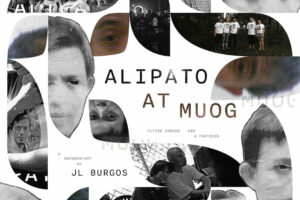Megalomania
CAME OUT of Megalopolis feeling a lot of things but what I did not feel was disappointed — not a bad thing but not necessarily a good thing either.

Movie Review
Megalopolis
Directed by Francis Ford Coppola
MTRCB Rating: R-16
CAME OUT of Megalopolis feeling a lot of things but what I did not feel was disappointed — not a bad thing but not necessarily a good thing either.
I run hot and cold on Francis Ford Coppola. Thought his first two Godfather films were classically well-written if visually conventional, too-carefully curated portraits of a corrupt American family, thought Apocalypse Now was a vividly directed Vietnam war movie that had little to do with the actual war, thought The Conversation (easily his best early work) was a nicely done portrait of loneliness and introverted paranoia.
I actually prefer Coppola’s wilder, less disciplined later works: the lowkey monochromatic Rumble Fish, the emotionally extravagant One From the Heart (my favorite), the beautifully mounted Bram Stoker’s Dracula (despite Keanu Reeves as an allegedly British real estate agent, and a haphazardly grafted love story), and now this, his wildest most undisciplined yet, basically a retelling of the Catilinarian conspiracy transposed to modern-day New York.
Call the picture a prequel to Fritz Lang’s Metropolis, only instead of telling how the city heaved in conflict and was nearly brought to ruin, Coppola tells of how the city was constructed despite all odds.
The setting is America, only an alternate America where Rome didn’t fall, and the nation’s greatest city New York is instead called New Rome (maybe the most unsettling element in this parallel world is the total lack of an Asian presence — no Filipino faces, no Indian saris, no Chinese calligraphy on storefronts or billboards, no sushi or izakaya or Korean BBQ shops, it’s as if half the planet had ceased to exist).
Two men face each other in opposition: architect/inventor Cesar Catilina (Adam Driver) and mayor Franklyn Cicero (Giancarlo Esposito). Catilina wants to build Megalopolis, a city within the city; Cicero opposes Catilina because… well it isn’t clear why. We’re supposed to assume Cicero, being one of the city’s powers, is threatened by Catilina’s rising trajectory, and feels he must bring the younger man down; their conflict reads as Coppola’s parable on an iconoclast threatening the studio-established status quo, the city itself a metaphor for this passion project the said iconoclast took over 40 years to make.
Cicero is readily countered though — he happens to have a daughter Julia (Nathalie Emmanuel) who takes it upon herself to investigate Catilina, his private life, and the possibility that he murdered his wife. Julia draws closer to Cesar, and… well you can guess the rest.
The conflict represents only half the dramatic fireworks: in the B plot Cesar’s mistress Wow Platinum (Aubrey Plaza) leaves Cesar to marry Hamilton Crassus (Jon Voight), Cesar’s uncle and banker, then schemes to keep her former lover under her thumb.
On top of startling effects both practical and digital, the intricate set design, the various cameras and lighting equipment put to innovative use, there’s the acting which, to put it charitably, is highly stylized — a caricaturish, even cartoonish, version of the kind of larger-than-life performance you see in opera, probably cultivated through Coppola’s acting exercises and constant improvisation. Results can be bizarre — Shia Lebouf as Clodio (Cesar’s jealous cousin) was reportedly a nightmare to deal with and some of his unpredictably is caught onscreen. Of the cast Driver, Emmanuel, and Esposito are allowed to retain their dignity (to their relief I’m guessing), while Aubrey Plaza as Platinum seems able to internalize all that stylization and produce her own aura of comically sensual menace — think an unholy cross between Ida Lupino from They Drive by Night and Linda Fiorentino from The Last Seduction only funnier, the single best piece of evidence on film that Coppola might be on to something here, acting-wise.
Megalopolis is to be constructed out of Megalon, a “bio-adaptive” material invented by Cesar apparently out of his grief and passion for his dead wife. Not only is it capable of creating unusually organic structures, it enables Cesar to stop, rewind, fast-forward time; cause objects to rise in the air; heal bullet wounds; receive light on one side and transmit it on its other (essentially allowing any tunic made of the material to become invisible). Megalon is in effect Coppola’s mega-macguffin, a plot device to turn Cesar into the film’s Prospero, taking to the stage in his final appearance in Coppola’s (sorry, Shakespeare’s) final play.
Maybe my biggest problem with the film (other than the “stylized” acting) is how vague this all is — “Megalon” being the biggest sin, up there with James Cameron’s “Unobtanium.” Is the material psychoactive? Is it manufactured or grown? What goes into its production? How can it be employed? The finished city is only partly visible, obscured by the fact that the material glows like a mass of optic fibers, or Hollywood’s notion of the human spirit lighting it up from within (Coppola reportedly looked at the designs of Neri Oxman, who has a cameo in the film and who fabricates what might be called biologically inspired material — looking at pictures of her exhibits and the constructs on display, they have a fascinating solidity and complexity of texture the filmmaker’s “buildings” never manage to achieve). Half the surreal images in this film can apparently be explained by Megalon, which takes away from surrealism’s magic (a trick loses power when explained), at the same time it leaves the more rational with too many unanswered questions. Questions that, when you think about it, can easily remain unanswered if they had been asked in an early scene then dismissed, preferably with a comic quip.
Comic dialogue or at least witty dialogue can cover or make up for a lot of sins, at least they do me, but Coppola and his cast are apparently too busy trying to come up with some kind of observational truth to bother. The only one who seems able to produce on the fly is Plaza — and it may be because she bats her huge eyes, flashes that wicked grin, and you’re dazzled into believing she’s being witty, or at least funny; her seduction of LeBouf might be a balletic comic classic.
(Skip this paragraph if you plan to see the film!)
On a more serious note, Coppola inserts shots of the homeless and hungry assembled in front of security barriers, shaking the fence links. Cesar never really gives them more than a glance; if anything, Clodio pays them more attention, if only because he believes them to be a source of power (they are, but at one’s peril). I can understand inserting the footage — Coppola wants to raise the dramatic stakes — but how does Cesar actually feel about these folk? He declares Megalopolis open to all, but how’s that supposed to work? Are millions supposed to just walk in and claim a building? What if someone pisses on a wall or picks up a tire iron and starts smashing? What if two people want the same dwelling? Details of how this new utopia will work, the philosophy underpinning it and why it’s so different might have helped, and I’m aware said philosophy might have already been stated and I might have missed it along the way. Like I said: vague.
The film’s pace is a slog for the most part; what helps sustain interest is Coppola’s visual style, and his vision of transforming New York — sorry, New Rome — sorry, the film — into Cesar’s — sorry Coppola’s — dream city — sorry, dream movie. The style works best when Coppola’s working with actual buildings, footage of which was shot years back on high-definition video and 24 fps digital cameras, later with sets and period exteriors made to look like New York (actually, various locations in Georgia, which offered tax incentives). He manages to make this mix of old footage, interior shots, and shots made to look like exteriors recall the scale and grandeur and variety of Lang’s Metropolis, which is quite an achievement (it helps that Metropolis itself was saddled with a sentimental half-baked script and God’s own arsenal of outsized models and fascinating practical effects).
Pause to note that Coppola does pay tribute to Abel Gance’s Napoleon (which he helped restore) with his occasional triptych imagery, and in one lovely moment evokes a scene out of Night of the Hunter, of Shelly Winters silently sitting in a drowned car, her hair waving languidly in the undercurrent — just some of the Easter eggs Coppola includes that I managed to recognize and recall, and they (the Laughton one anyway) are unforgettable.
Megalon isn’t the only element that affects the passage of time: when Adams and Emmanuel and Esposito are onscreen and we’re asked to believe in their romance and his opposition time passes slowly (I do eventually believe but it took effort, and a nod to Esposito for giving Cicero the necessary emotional weight — when his feelings start to shift it’s like watching a great battle cruiser changing course — and Emmanuel for making such a contradictory character, if not convincing at least intriguing, a mixture of the innocent and the knowing in a fragile suspension); when Plaza and LeBouf and Voight are onscreen the film kicks into high gear and purrs away in a manner that helps us accept the onscreen shenanigans as just part of the comedy (if Coppola had recast this as black satire the whole might go down easier).
But it is what it is, and Coppola apparently is sticking by this, his released version, opting for delirious romanticism over madcap chaos — which wouldn’t be the first time a longtime director’s late work has proven controversial or at least puzzling: Alejandro Inarritu’s Bardo: False Chronicle of a Handful of Hard Truths runs almost three hours and is even less comprehensible (I liked it); David Lynch’s Twin Peaks: The Return is essentially an 18 hour movie with an even more opaque plot and visual style (loved it). Coppola’s generation of ’70s American filmmakers are feeling their age and thinking of the legacy they’ll leave behind — I mentioned Lynch but there’s also Spielberg with his autobiographical The Fabelmans (liked it just fine), Scorsese with his long-gestating Silence (27 years — loved), Schrader with one small film after another, some of them career bests (Master Gardener, The Card Counter, above all First Reformed).
Brian De Palma has been quiet for some five years, though a search reveals he has two projects under development; Philip Kaufman hasn’t been heard from for maybe 12 years. Charles Burnett hasn’t done a fiction theatrical feature since the 1990s but has been surprisingly active, doing shorts and documentaries and TV work, and has two under development. Elaine May… she was inactive as a director for 26 years till she came up with an episode of American Masters for PBS focused on Mike Nichols (a brilliantly ambiguous work).
And so matters stand unless Coppola (as he’s been known to do in the past) starts tinkering with this “final product,” adding deleted scenes and fiddling with the running time — who knows? Someday we might get a Megalopolis we can actually like without getting a hernia from the effort.























